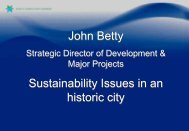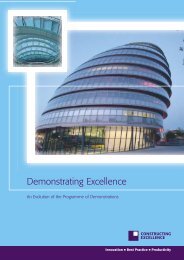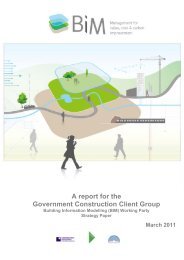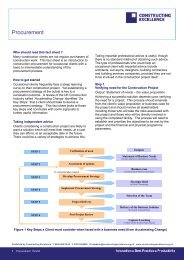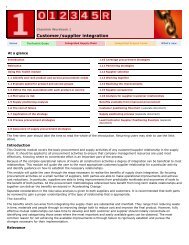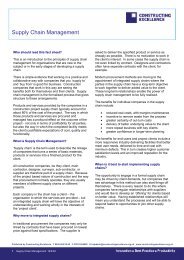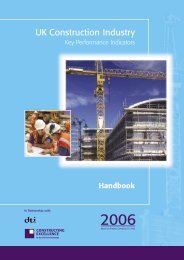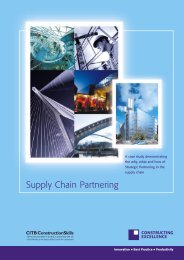Total Safety Management Taylor Woodrow - Constructing Excellence
Total Safety Management Taylor Woodrow - Constructing Excellence
Total Safety Management Taylor Woodrow - Constructing Excellence
You also want an ePaper? Increase the reach of your titles
YUMPU automatically turns print PDFs into web optimized ePapers that Google loves.
What to change to achieve total safety management<br />
The three biggest changes required are:<br />
■ 1. An attitudinal change - construction companies need to view<br />
safety and health as an integral part of their management of<br />
the business and ensure safety in design through to handover<br />
and operation of the property.<br />
■ 2. Process change - construction companies need to adopt better<br />
and more effective processes to improve their health and<br />
safety record.<br />
■ 3. Supply chain - to instill the same approach within the extended<br />
supply chain that operates in the construction sector.<br />
<strong>Taylor</strong> <strong>Woodrow</strong> has taken all of these changes on board and is<br />
now achieving performance above the industry average and above<br />
that of its peer group.<br />
The Health and <strong>Safety</strong> Process<br />
There are four parts to the process.<br />
Motivate Enable<br />
Ensure Improve<br />
Motivating the workforce<br />
<strong>Taylor</strong> <strong>Woodrow</strong>’s approach to motivating staff takes account of<br />
the different attitudes to safety that are present in any group of<br />
construction workers.<br />
For those in the workforce who are convinced of the benefits of total<br />
safety management <strong>Taylor</strong> <strong>Woodrow</strong> creates an environment where their<br />
ideas are welcomed and innovations adopted. The safety system recognises<br />
and rewards sites for implementing new ideas by setting them as exemplars<br />
that others are encouraged to copy.<br />
Unconverted<br />
Semi-converted<br />
Converted<br />
Incentivised<br />
Allowed to Compete<br />
Unleashed<br />
For those in the workforce who are less than convinced there are<br />
league tables that show up poor adherence to the safety management system<br />
and incentive payments that encourage good adherence to the safety<br />
management system. The league tables and bonuses work at site, region and<br />
business level. A poor performing site reflects badly on and affects the bonus<br />
of the site manager and all levels of management up to the Director responsible<br />
for that business unit. This carrot and stick approach applied in this way to<br />
the whole management chain focuses that management chain on safety.<br />
Enabling the workforce<br />
The <strong>Taylor</strong> <strong>Woodrow</strong> team understands how to work safely because<br />
they have the information they need and the skills required to use<br />
that information.<br />
Developing the skills<br />
<strong>Taylor</strong> <strong>Woodrow</strong> has developed a skills profile for each role showing which<br />
general courses the person must, should and could do. The skills profile is<br />
linked on the intranet to a course booking system enabling each person to<br />
review their training needs and book onto the courses they must, should<br />
and do need. There is no management authority required to book courses<br />
in this way, thus the team are empowered to develop their own skills.<br />
Courses cover knowledge, safety processes and skills and examples of<br />
course titles people can book include:<br />
Knowledge<br />
Process (Institute of<br />
<strong>Safety</strong> and Health)<br />
Skills<br />
Basic <strong>Safety</strong>, Health and Environment<br />
<strong>Safety</strong> Health and Environment Update<br />
• Directing <strong>Safety</strong> • Managing <strong>Safety</strong> • Supervising <strong>Safety</strong> •<br />
• Client/Contractor Relationships •<br />
• Managing Environmental Issues •<br />
• <strong>Safety</strong> Awareness • Scaffold Awareness • Fire and Emergency •<br />
• Lifting Operations <strong>Management</strong> • Elevating Work Platforms •<br />
• Slinger Banksman Awareness • First Aid • Nets • Fork Truck •<br />
On a day-to-day level the site managers are equipped with “Tool Box Talks”<br />
that allow them to brief the workforce on specific safety issues. There are<br />
78 of these on the <strong>Taylor</strong> <strong>Woodrow</strong> intranet site that cover topics ranging<br />
from Safe Use of Hand Tools, Safe Use of Ladders, Working from Cradles<br />
and Prevention of Falls.<br />
Informing the workforce<br />
Good health and safety is captured in a series of processes for the setting<br />
up, operating and closing down of a site. These processes cover everything<br />
from the site compound through to traffic management. The site team<br />
can access forms and checklists for every stage of the build process.<br />
Additionally there is guidance on other aspects of health and safety; for<br />
example risk management, method statements and standard forms. These<br />
internal documents are supplemented by standard publications such as<br />
CITB Construction Site <strong>Safety</strong> Notes, GE700 and other technical information.<br />
Normally in companies this information is only available to the Health and<br />
<strong>Safety</strong> Team; at <strong>Taylor</strong> <strong>Woodrow</strong> it is available 24/7 to all employees. In<br />
addition to the standard, there is practical guidance on implementing<br />
health and safety. Usually derived from best practice developed on site,<br />
this practical guidance is in the form of descriptions and photographs.<br />
Setting standards by visualisation in this way brings to life the typically dry<br />
materials offered by many reference sources.<br />
As practice improves and procedures change <strong>Safety</strong> Reminders are issued<br />
via email and logged onto the company intranet.<br />
A knowledge based system<br />
Collectively this knowledge base ensures the workforce is informed of both<br />
minimum standards and<br />
good practice required to<br />
plan and deliver a project<br />
safely. For <strong>Taylor</strong> <strong>Woodrow</strong><br />
this is implemented via the<br />
company’s intranet site<br />
- Tayweb - to which a<br />
majority of employees<br />
have access.<br />
Area<br />
Processes<br />
Knowledge<br />
Measurement<br />
Competence<br />
Improvement<br />
Groups<br />
The Team<br />
Occupational<br />
Health<br />
OHSAS<br />
18001<br />
Purpose<br />
To explain<br />
how the<br />
safety process<br />
operates<br />
A single point<br />
of access to<br />
internal and<br />
external<br />
information<br />
on safety<br />
To set out<br />
what is<br />
measured<br />
and how it<br />
is measured<br />
Details of the<br />
skills required<br />
and training<br />
available<br />
Details of<br />
how the<br />
improvement<br />
processes<br />
operate<br />
An<br />
organisation<br />
chart for the<br />
safety advisors<br />
To ensure the<br />
health and<br />
well being of<br />
all employees<br />
A Health<br />
and <strong>Safety</strong><br />
Standard<br />
Examples of information held<br />
■ Health and <strong>Safety</strong> Plan<br />
■ Where to find advice<br />
■ How to measure<br />
■ Incident response<br />
■ Process forms and documentation<br />
■ External information<br />
• CITB Yellow Bible<br />
• CIP Blue Bible<br />
• British Standards Online<br />
• HSE information<br />
• Barbour index<br />
• SYPOL covering COSHH<br />
• H&S Related Websites<br />
■ Internal information<br />
• Company policy and strategy<br />
• Risk Assessment Standards<br />
• Innovations - how to achieve total safety<br />
• Toolbox Talks<br />
• Site <strong>Safety</strong> Starter Pack<br />
• <strong>Safety</strong> Reminders<br />
• <strong>Safety</strong> Manual<br />
• <strong>Safety</strong> Newsroom<br />
■ <strong>Management</strong> Performance - quarterly league tables<br />
summarising the findings of document audits<br />
■ Site Inspections - quarterly league tables summarising<br />
the findings of observational audits<br />
■ Benchmarks - statistics on health and safety<br />
performance for the industry<br />
■ Training matrix<br />
■ Details of courses and online booking for training needs<br />
■ Details of competency targets & MCG accepted schemes<br />
■ Corporate Social Responsibility Policies<br />
■ CSR Meeting Schedules<br />
This chart shows who to contact and how for<br />
a range of safety advice. It is “hot linked” for<br />
ease of emailing.<br />
■ Company policies<br />
■ Medical Advice and Guidance<br />
■ Health Screening<br />
■ Subcontractor Health Screening<br />
Online access to the standard<br />
Ensuring safety<br />
<strong>Safety</strong> happens because staff are motivated, trained, informed<br />
and responsible.<br />
The safety regime involves the whole workforce; main board directors are<br />
involved in strategy and reporting; regional directors and business units are<br />
held accountable for performance, and operations (design, costing, procurement<br />
and engineering staff) are responsible for creating safe approaches<br />
to construction.<br />
A significant part of the management system is the audit regime that involves<br />
the advisor working with each site. This takes two forms: the scheduled<br />
<strong>Management</strong> Performance Audit checks that the procedures are in<br />
place and the unscheduled Site Inspection checks the implementation<br />
of those standards.<br />
The <strong>Management</strong> Performance Audit - To establish the management<br />
of the site complies with the Health and <strong>Safety</strong> Plan the advisor visits 3, 6<br />
and 12 monthly according to risk (higher risk sites receive more frequent<br />
visits). They are evaluated on a predetermined schedule and scores reported<br />
to all in the management chain up to and including the Managing Director<br />
of the Business unit.<br />
The Site Inspection - measures the operational effectiveness of the<br />
works on site. The site is visited unannounced and checked against a<br />
series of standards. The rating system is a ten-point scale where 10, 9<br />
and 8 reflect activities that go beyond that required by law.<br />
Score Meaning<br />
Status<br />
10<br />
9<br />
8<br />
7<br />
6<br />
5<br />
4<br />
3<br />
2<br />
1<br />
0<br />
Unique - this is the first time the Advisor has<br />
seen this<br />
A model of good practice adopted by less than 25%<br />
of TW sites<br />
Good practice adopted by less than 50% of TW sites<br />
Meets the law - it is standard industry practice<br />
Dangerous review and correct<br />
Correct within a week<br />
Correct within three days<br />
Correct within one day<br />
Correct immediately<br />
Stop the activity<br />
Stop the job<br />
Above compliance<br />
Compliance<br />
Non conformance<br />
The results of each inspection are published through the management chain<br />
at the time of visit. They are consolidated and reported at site, area and<br />
business level. The safety performance of each Director and those who report<br />
to him/her is published and used to calculate part of the bonus payment<br />
to each business. Publishing these figures is a key motivator for improvement.<br />
The checklist is revised as new innovations are adopted more widely<br />
across the company. When an innovation is first identified it scores 10,<br />
when more than 25% of sites do it, the score is reduced to 9; when more<br />
than 50% do it the score is reduced to 8 and when it becomes the industry<br />
norm it is reduced to a score of 7. This way people are forced to continue<br />
innovating to top the league table and maintain the score required to<br />
achieve the bonus payments.<br />
8 <strong>Constructing</strong> <strong>Excellence</strong> ■ <strong>Total</strong> <strong>Safety</strong> <strong>Management</strong><br />
Innovation ■ Best Practice ■ Productivity 9



